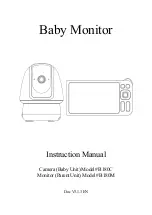
S7999D1048 COMBUSTION SYSTEM OPERATOR INTERFACE DISPLAY
65-0321—01
42
Fig. 89. Fuel Preset Settings.
The “Diagnostics” button displays diagnostic information about
the Fuel/Air Ratio Control (Fig. 90). Current hysteresis value
can be viewed or changed by selecting the “Hysteresis” button.
See the Set Hysteresis section for more information regarding
this button selection.
Fig. 90. Fuel/Air Ratio Control Diagnostics.
The “Show Faults” button displays the Fuel/Air Ratio Control
fault history (Fig. 91 and Fig. 92) in the same manner that it
does on the Fuel/Air Ratio Control status page. This button
provides another place to display these faults.
Fig. 91. Fuel/Air Ratio Control Fault History, left view.
Fig. 92. Fuel/Air Ratio Control Fault History, right view.
Set Hysteresis
This feature is available for all ControLinks™ Fuel/Air Ratio
Control software builds
except
127, 140 and 176 (see Fuel/Air
Control Configuration screen for build number). The Fuel/Air
Ratio Control must be updated to use this feature. This feature
is also only available for the Fuel/Air Ratio Control attached to
a S7999D COM port that has been configured for "Fuel/Air
Ratio Control only (Commission)”.
The hysteresis value controls the amount of hysteresis for the 4
to 20 mA firing rate (CmA) input signal. Adjusting the
hysteresis value determines when the R7999 reacts to a firing
rate change in the opposite direction. The R7999 only reacts to
a firing rate change in the opposite direction when it has
increased/decreased more than the user-selected hysteresis
value. However, the R7999 always follows the firing rate signal
as it changes in the same direction.
For example: When a hysteresis value of 0.5 mA has been
selected and the firing rate drops from 12 mA to 10 mA, the
R7999 will not begin to follow an increased firing rate until it
increases to a value of 10.5 mA or higher. All firing rate values
between 10 mA and 10.5 mA are interpreted as a value of 10
mA. The configured actuators remain at their corresponding 10
mA firing rate position until a new firing rate is accepted.
Increasing the hysteresis value may reduce the amount of
actuator dither/hunting and premature wear-out due to a noisy
environment or an intelligent firing rate controller continuously
attempting to satisfy a very precise setpoint.
Use the left/right adjust bar on the Hysteresis screen for large
changes to the hysteresis value (Fig. 93). Use the up/down
buttons on the bottom of the screen to slowly fine-tune the
desired hysteresis selection. Pressing the “Set Hysteresis”
button will cause the R7999 to reset and the new value will be
written into nonvolatile memory.
The user is asked to confirm setting the hysteresis to the new
value (Fig. 94). The “Reset to Current” button causes the
current value to be copied to the proposed new value field,
similar to an undo operation. See Fig. 93 and 94.
Summary of Contents for S7999D1048
Page 70: ...S7999D1048 COMBUSTION SYSTEM OPERATOR INTERFACE DISPLAY 65 0321 01 70 ...
Page 72: ...S7999D1048 COMBUSTION SYSTEM OPERATOR INTERFACE DISPLAY 65 0321 01 72 ...
Page 74: ...S7999D1048 COMBUSTION SYSTEM OPERATOR INTERFACE DISPLAY 65 0321 01 74 ...
Page 75: ...S7999D1048 COMBUSTION SYSTEM OPERATOR INTERFACE DISPLAY 75 65 0321 01 ...
















































